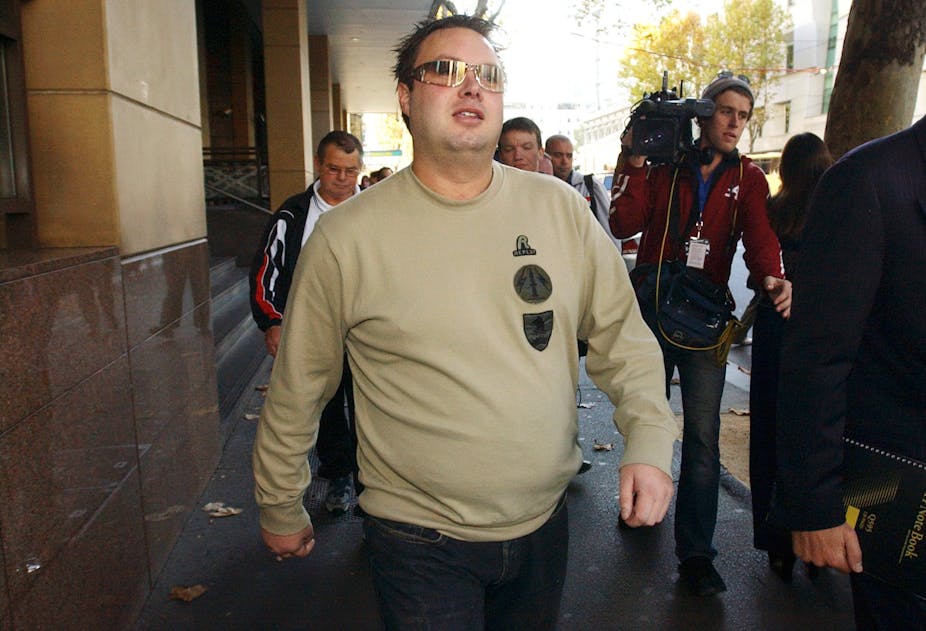In 2007, the infamous underworld figure [Carl Williams](http://en.wikipedia.org/wiki/Carl_Williams_(criminal) pleaded guilty to one count of conspiracy to commit murder and three counts of murder, on the basis of a plea deal struck with the Victorian Office of Public Prosecutions (OPP).
This deal involved drug trafficking and murder charges being withdrawn and investigations into his involvement with another five murders being concluded. Almost five years later, another infamous crime figure in Victoria’s gangland wars, Tony Mokbel, was sentenced to drug trafficking offences, after having pleaded guilty to a deal struck with the OPP, which allegedly included the withdrawal of eight additional drug-related charges and his involvement in up to three murders.
Plea bargaining across Australia
Victoria is not alone. Examples of plea bargaining and contentious deals can be found across all Australian jurisdictions. In NSW, Karl Koch was charged with the attempted murder of his former girlfriend Nanette May, who was beaten so severely that she has ongoing motor co-ordination problems.
In reaching a deal with the NSW Department of Public Prosecutions (DPP), Koch was able to plead to the lesser offence of malicious injury with intent in 2009, despite significant evidence suggested he stalked and planned to murder May.
In South Australia, the somewhat renowned Nemer plea deal resulted in a challenge in the Full Court of the Supreme Court in 2003, to allow the Government to intervene and force a Crown appeal against the inadequacy of a sentence imposed, which was the primary result of a favourable plea deal struck between Paul Nemer and the DPP. In this case, Nemer had shot and severely injured a newspaper-delivery man, after mistakenly believing the victim was stalking two of his female friends.
How plea bargaining works
Plea bargaining essentially involves a private negotiation between the prosecution and defence lawyer on the charges, case facts and/or prosecution’s sentencing submission. For example, reducing murder to manslaughter, or withdrawing one charge to allow a guilty plea to fewer charges.
Its primary aim is to arrive at a mutually acceptable deal between the prosecutor and the defence, which results in the accused pleading guilty. This process is often justified for its efficiency benefits, as it saves money and resources and spares victims and accused persons from prolonged proceedings.
Transparency?
Although offering these benefits, plea bargaining is a largely non-transparent process to those outside the bargaining room. Across most Australian jurisdictions, plea bargaining is not recognised in or controlled by any legislation, and no external data is kept as to when or why plea bargaining occurs, which limits public understanding of the process and can raise doubts over the motivations underpinning the deals and the subsequent legitimacy of the agreements made.
This is largely because plea bargaining falls under the discretionary powers of the prosecution, which means the public is left to trust that the parties involved in the process have upheld the same judicial principles that would apply to a conviction reached after trial.
When a matter is resolved by a guilty plea, the full circumstances surrounding the offence are generally not publicly available – even in the Mokbel and Williams cases, the number of charges withdrawn and investigations concluded in order to gain their guilty pleas are based on partial information and conjecture.
A question of justice?
The absence of disclosure is concerning, because it means in many instances where plea bargaining is used, it is impossible to tell if a more or less serious conviction may have been appropriate. This raises the risk that offenders’ convictions may not match their culpability, and that the public cannot then determine if these offenders were convicted and sentenced appropriately.
This is concerning from the perspective of the victim and the accused, given that plea agreements can alter the seriousness of the conviction and sentence imposed, and can remove the opportunity for the victim to provide testimony or for the prosecution to prove its case within the confines of the rules of evidence applied at trial.
The key issue at play thus becomes the factual guilt of the accused, “in the sense that the accused probably committed the criminal act”, as opposed to proving guilt beyond reasonable doubt.
We need plea bargaining, just done better
Without question, there is a place for plea bargaining. Indeed, our justice systems would grind to a halt if all cases proceeded to trial. However because the plea bargaining process is not transparent to those not directly involved in the deal, criminal matters, some involving the most serious form of misconduct, are being resolved in secrecy.
Consideration should be given to greater external transparency of plea bargaining, even simply introducing a register to keep track of when these deals occur. In accordance with Charlie Bezzina’s discussion of the Mokbel plea bargain in Victoria, “these deals are an essential tool in saving court time and costs, but … closer scrutiny needs to be applied to these matters”. It would be a significant achievement to see informed and considered changes to plea bargaining across Australian criminal jurisdictions.

